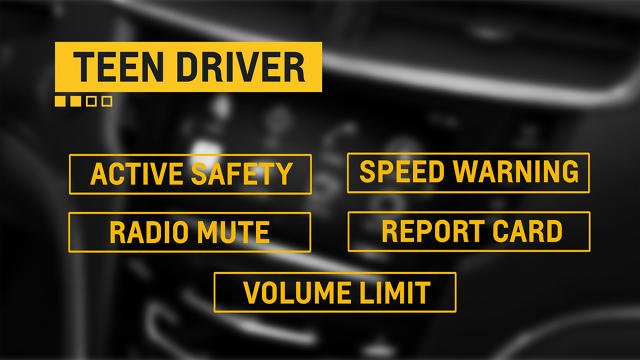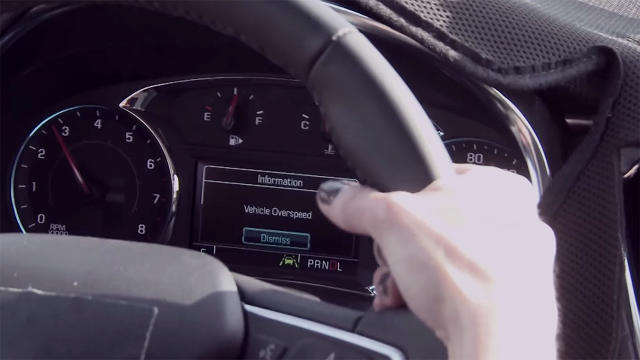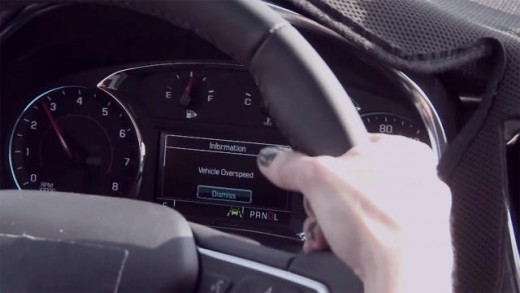Auto Update: How “Teen Driver” Hopes To Give Cars A Major System Upgrade
GM insists the parental control program isn’t “Big Brother,” but a way to usher in more complex automotive software upgrades.
“Okay, unbuckle your seat belt,” the GM spokesman tells me over the din of a cranked Sirius station. I undo the belt of the 2016 Chevy Malibu. In a “click,” the radio stops instantly.
The no seat belt/no radio feature is part of Teen Driver, a software program that lets parents remotely cap the maximum radio volume, set alerts that warn teens when they’re exceeding pre-set speed limits, and give a report card showing how many times the forward collision alert warnings and lane drift warnings went off and anti-lock braking was used.
Due out this fall, the 2016 Malibu will be the first GM car to offer Teen Driver. GM does not expect it to be the last.
Although the seat belt/no radio control isn’t new—Ford’s MyKey, introduced in 2008, does the same thing, as do aftermarket products like Tiwi. But GM’s building a report card into the car is novel. Parents can check it via the car’s built-in infotainment screen (which is about the size of an iPad mini).
The system is backed up by research that suggests technology does improve teen driving habits. Russ Rader, a spokesman for the Insurance Institute for Highway Safety, an insurance industry-funded nonprofit, says “teens behave better behind the wheel, they drive more safely, when they know that mom or dad is monitoring them.” Mom and dad can’t always be sitting there, but technology can extend that sense of monitoring.
To make it work, parents have to establish a PIN, pair Teen Driver to one of the two key fobs that come with the car, and decide the settings. It can be set to beep when driving above certain speeds (from 40 to 70 mph), and to automatically turn on forward collision warnings and lane drift warnings. They can also set the maximum volume for the radio when the teen is driving. Once set, these monitors cannot be turned off by the teen (unless they get access to the PIN and the fob). The report card will also show how many miles were driven and the maximum speed it hit. Parents have to physically check the report card in the vehicle; GM will not in this version send alerts to the parent via phone or email.

In a smartphone world, forcing parents to check the car’s report card might seem inconvenient. But “it’s not a nanny or a Big Brother,” said Joe LaMuraglia, the GM spokesman who showed me the Malibu. The IIHS study found that teens whose car had a web alert were less likely to respond to speed limit warnings than those whose parents had to check a report card, because they thought they could correct their mistake and not have their parent find out.
Teen Driver shows that GM is thinking more digitally. If GM decided to add a nanny feature, it could do so via a straightforward software upgrade. Similarly, if parents wanted settings for multiple teenagers, GM could, again, just upgrade the software. That ability could create stronger residual values for used cars, which could in theory also get upgrades. Such upgrades, for now, would be done at the dealership; GM has not announced plans to do software upgrades over the air. But the 2016 Malibu will also be the first GM car to offer, for a fee, 4G LTE Wi-Fi.
“This is one tiny example of how you begin to think about expanding the capabilities of cars and building in an initial digital experience” for consumers, said Frank Gillett, an analyst at Forrester Research. Gillett said he expects to see many more such offerings emerge from automakers. “Carmakers have to remake their products as digital experiences that work the way people expect, from their experience with smart phones. The car has to give you information.”
Gillett also said it was smart of GM to offer the feature as part of car’s configuration, rather than trying to sell it as an extra feature.
That Teen Driver will first appear in a mainstream car like the Malibu, which will probably sell for about $24,000, signals how once-pricey technologies like collision control warning have become more widespread, said MaryAnn Beebe, the GM safety engineer who developed Teen Driver. It’s also a sign of how far sensors are spreading: Sensors in the seats let the system know when someone is sitting there, meaning the seat belt should be buckled. Beebe said it took a couple of years to develop the report card feature, because of the challenge of integrating the various systems to create it.
Is Teen Driver enough of a feature by itself to boost sales? At first blush, it seems like a natural draw for parents of new drivers. For one thing, statistics from the Centers for Disease Control show that motor vehicle crashes are the number-one killer of U.S. teens. The Insurance Institute for Highway Safety says drivers aged 16 to 19 are almost three times more likely to suffer a fatal car crash than drivers 20 and up. About half of 16- and 17-year-old drivers killed in crashes weren’t wearing their seat belts.
But parents balked at merely participating in that 2009 IIHS study involving Tiwi, Rader said. “There was a sense that parents didn’t want to add this other ‘I don’t trust you’ layer on the driving front,” he said. “There is a question to what extent parents are going to be willing to use these systems.”
Beebe said GM’s recent focus groups with parents and teens found less resistance to the technology. She said teens even appreciated the seat belt reminder. What they didn’t like was that parents could set the audio volume levels. “The parents chose to set it much lower than where the teen chose to set it,” Beebe said. “That’s probably the one (the teens) liked the least.”

Will Teen Driver amp up GM’s cool factor? Probably not. But for me, as a parent of a teenage boy who is not far from driving, it automatically puts the Malibu on my test-drive list (I like the air-conditioned front seats, too; the 2016 Malibu looks like the cheapest non-Kia to have this feature). The statistics show boys 16 to 19 get in twice as many accidents as girls of the same age. We’ll see if remote backseat driving is the answer.
Fast Company , Read Full Story
(134)



